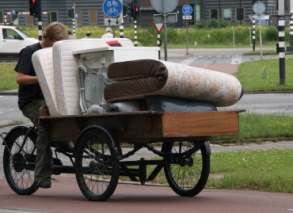Moving Without a Mover

- Preparation is crucial – Make a list and figure out what to take home; scrap or sell the rest. You’ll figure out how many boxes you need and what size moving-vehicle is required. This will save time and money.
- Get help – Ever tried to load a mattress into a car/truck on your own? Now imagine an entire room. Ask friends for help or scour Craigslist. You don’t need to be a hero.
- Pack smart – Don’t be shy when using boxes, tape and bubble wrap. Buy your packing materials from a hardware store or online. It will cost less than half of what a moving company or campus bookstore will charge you.
- Get some wheels – Your options are your car, trailers (2 rooms or less), or trucks (1.5 to 8 rooms). Check U-Haul, Budget and Penske to comparison shop. On pick-up day, arrive early so you can get the dibs on the best rides. When loading your vehicle, remember to distribute weight evenly.
- It’s not easy – I don’t care what people tell you; moving yourself is a big pain in the butt. It takes days to prepare, pack, load, drive, unpack, return your vehicle, etc. And the labor is backbreaking. If you have the cash, consider spending it to hire a professional, instead of spending your final days at school lifting boxes.
Some of you will be moving home, some to a new city, some to an apartment on the other side of town. But the fact is that after graduation, you’re all going to be moving somewhere. Unfortunately, the one constant in any moving enterprise is that it sucks.
Not only does it always turn out to be more time intensive and expensive than it initially seems (“$20 a day” for a U-Haul van—yeah right), but it will also strain backs, patience, and friendships if it’s not done correctly. But hey, your friends won’t mind helping out…right guys?
Step 1: Making a List
The first major pitfall in self-moving is not knowing exactly how much stuff you have. My friend and I once rented a U-Haul that at first glance looked far larger than either of us would need but was soon filled up with only half of my senior year studio. I spent the day making last minute decisions over what could stay what should go, inevitably forcing my friend to wrench a life-sized Darth Vader statue from my death grip. Better to do that work beforehand and figure out exactly what you’re going to take and what you’re going to sell or scrap. Then try to gauge how many boxes you'll need and how large your bulkier items, like couches and beds, actually are. Be conservative in the estimate. It’s always better to have more truck space than you actually need so you don’t have to get rid of prized Transformer action figure collections. Also, remember that the reason that Ikea and Target furniture is cheap is because it’s usually, well, cheap and will likely not survive being bounced back and forth between bookshelves and bowling balls.
Step 2: Wrangle the Moving All-Stars
Unless you have a Ver Magnussun at the end of your name, there’s no way you’re going to get all of your crap in or out on your own. Boxes, miscellaneous junk, no problem. Couches, beds, bookcases—no way. The first logical place to start is with friends. Offering free beer was an easy way to get them to do your Stats homework, so it may very well work again. That being said, most of your friends will likely be dealing with their own moving hassles so will refuse even the most liberal of libational offers.
The next place to turn is to the school message boards (electronic or physical). Try posting an ad offering beer, cash, or sex and see what comes up. You could also try expanding the labor pool by hitting up Craigslist and clicking on the “volunteers” subsection under “community”—good luck getting one of those—or heading to the “labor” subsection under “gigs.” For a little more cash, you could check out an online moving labor marketplace such as U-Haul’s. Or, if you're not gunning for that J.D. any time soon, cruise the parking lot of the local Home Depot. Cheap laborers often line up looking for quick jobs from contractors, so you can probably convince a couple to lend you a hand. A bit shady, but you know what they say about desperate times...
Step 3: Get the Wheels
So, now it’s off to U-Haul, Penske, or Budget—the three behemoths of self-moving. With so many models to choose from, it's tough to decide which van you want. The first decision should be whether you need a trailer and a truck. Obviously, if you don’t have a car to hitch trailer to, it’s not much of a choice at all. But even if you do, a trailer might not be the best option. U-Haul provides detailed specs on trailers, as does Budget for trucks.
Trailers (< 2 rooms)
A trailer is ostensibly the cheapest option of the bunch, costing around $100. But they craftily don’t mention how you are going to hook the trailer up to your car. For that you’ll need a tow hitch—basically a piece of metal that connects the trailer to your car. Though you could buy a hitch online and install it yourself, it’s probably best to get a pro to help in order to avoid a runaway living room on I-95. You first have to call your local car dealer to see if you can even attach a hitch, and, if so, whom they would recommend doing it. Check out these tow hitch FAQ’s for more info. Then you have to call the folks at U-Haul and ask if your car is one of the models that they allow to pull their trailers. If all’s good you should expect to spend a day and $300 for installation.
Trucks (1.5 – 8 rooms)
Most people will likely opt for a truck, and the main question here is how big? A small 10’ truck can transport up to 1.5 rooms and should cost around $475 per trip. A large 26’ truck can tow up to eight rooms and should cost around $650 per trip. These trucks get about 6-12 miles per gallon (quotes based on a trip from Atlanta to New York City). If you were dutiful in step one, you should have a good sense of which size you need. One room studio, 10’. Four bedroom house, 26’. But what about car owners? Are they stuck dealing with the whole hitch hassle? Not necessarily. Any truck rental place also rents vehicle tows. They come in two different forms: two- and four-wheel tows for around $120 and $240 per trip, respectively. Obviously, the four wheel tow is better for your whip since it stays completely suspended for the entire trip, but the two wheel tow isn’t a bad option and, if used correctly, won’t screw up your wheels too much. Note: U-Haul allows any of their trucks to pull a vehicle, while other companies require that only the bigger trucks do so.
Step 4: Comparison Shopping
While all the major rental companies charge similar amounts, they also have price guarantees, which means you can play them off against one another. Sneakily enough, all these companies charge more per truck or trailer in high demand areas. So the U-Haul location near school is probably significantly pricier than the one on the other side of town. Try getting the local shop to lower its price by shaming them with the other location’s prices. If nothing works, then consider sucking up the thirty minute drive (it might well be worth it). Really crafty renters can make a visit to the post office, since most offer “moving guides” that tend to be chock full of coupons (sometimes up to 10% off). Finally, once you’ve decided on your truck of choice, reserve it early. Especially at heavy moving times, these babies go fast! And don’t forget about insurance.
Step 5: It’s Your Crap in a Box
Everyone tries to screw you on box buying. Moving companies charge the most; up to $8 for a big one. Truck rental locations (e.g., U-Haul, Budget, Penske) and hardware stores (Home Depot) are a bit better, charging about $4. If you plan ahead, you can buy boxes wholesale from an online store like Uline, which will run you only $1.50 per box, but you'll have to buy at least 15 at a time. Not a bad idea to go in with friends on this one. For the really frugal, check the local supermarket or liquor store—many stores put their delivery boxes on the curb, but they also may slash them for easy tying. Check to make sure those boxes are in one piece before dragging them all the way back to the apartment. For tips on packing those boxes, check out About.com’s packing tips and Penske’s quick list of how to pack specific items.
Step 6: Load Up
Get to the rental place nice and early. They always send the better trucks out first. Put in the heaviest items first (closest to the cab) and try to distribute the items evenly on both sides of the space. Try to secure everything so it doesn’t bounce around like a whistle-tooting raver. For even more trailer/truck packing tips, head on over to U-Pack’s loading tips.
Step 7: On the Road
Remember that most of these trucks have like a ten degree turning radius and they don’t exactly stop on a dime. U-Haul suggests that no one who is towing a trailer should drive above 45 miles per hour. They also guzzle gas, so check the gas gauge regularly (if it works) and don’t try to push it till that next exit. If possible, bring a friend. The radios usually don’t work, and it’s pretty stressful driving a eight ton tank for ten hours. If you do get tired, take a nap or let the friend take over. An out of control U-Haul can cause some serious damage.
If anything goes wrong, remember that the big emergency number is there for a reason, so call up the company and ask for help. When it comes to long drives, going with one of the big companies is worth the extra money since they have call centers and hundreds of other locations en route. Having a AAA membership doesn’t hurt, either. In addition, some credit cards and cell companies (e.g., AmEx, Cingular) provide on-demand road-side assistance.
Step 8: You’re Home!
Bring it all upstairs. Crack a beer. Take a nap. Oh wait, maybe you should return the truck first.






Comments
(4)I recently posted my extremely comfortable bed on Craigslist and a dude emailed me saying he wanted the bed but would need me to pay his mover for him as he couldn't come pick the bed up himself. He wanted me to use Western Union and he wanted to send me more money than I was charging for the bed so that I could send the difference to his mover. This was obviously a scam artist doing his damndest to take my money. This story is not unique to me so be wary of scammer pricks when selling things on Craigslist or any online goods-trading site.
That's so scary. Is there anyway to screen ppl on craigslist before they scam you? Do you guys find amazon to be more reliable?
Last time I rented a truck they surprised me with $1/mile they didn't quote me on the website. My neighbor rented a truck to move and it broke down in Needles CA. Okay, could have been been Death Valley, but still. I suggest you also try the PODS option. You pack it, they move and/or store it. I'm using them for my move to Florida this month. You rent the container by the month, so no rush to beat the late return charges.
One of the very reasons to own a pick up truck or know someone who does (unless of course you're moving across the country.) I would have to agree with David, the PODS option is probably the best for long distance moving. For anything short, grab a trailer rental from any of your local moving companies. I've had some mediocre experiences with U-Haul but I guess I can't blame it on them as a whole as they do not own or completely control each of their moving or storage franchises.
POST YOUR COMMENT